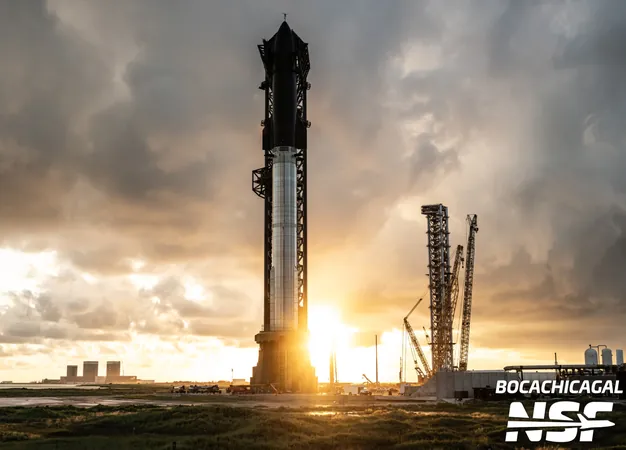
Countdown to SpaceX's Starship Flight Five: Exciting Developments and Anticipation!
2024-09-24
SpaceX has successfully completed initial pre-launch testing of its Flight 5 Starship, but eager fans may have to wait a bit longer, as the launch date is currently projected to be two months away. The Federal Aviation Administration (FAA) does not expect to issue the necessary launch license until late November or early December.
Since the beginning of this year, the Starship program has been in overdrive, with Ship 30 and Booster 12 subjected to an extensive and rigorous testing schedule. Ship 30 has gone through an array of tests, including cryogenic proof tests, spin primes, and static fire operations, all designed to ascertain the ship's durability under the intense conditions of launch. Impressively, these tests have confirmed that the Raptor engines are primed and ready for flight.
Meanwhile, Booster 12 has also engaged in several significant tests on a grander scale. Notably, on July 15, it completed a full-duration static fire test, igniting all 33 engines simultaneously, confirming the booster’s capabilities for the upcoming mission.
Recently, Booster 12 was rolled out of the Mega Bay to the launch site on September 20, where it was maneuvered to the launch pad by using the formidable “chopsticks,” which lifted the booster for around twenty minutes before securing it on the orbital launch mount (OLM). This lift simulation was crucial in understanding the stress the booster would experience during a potential landing.
The preparations for the Flight Five mission don't stop there. Ship 30 also made its way to the launch site, preparing to be stacked onto Booster 12. Alongside the vehicles, the launch pad has received significant upgrades. The chopsticks have been reinforced to improve their landing capabilities, including new bumpers that will help cushion the booster upon touchdown, and enhanced struts to minimize strain during operations.
Although the launch isn't expected for some time, conducting early stacking will help validate various systems related to the Flight Five mission. SpaceX managed to roll out Booster 12, stack it with Ship 30, and complete this assembly in just over 36 hours—an impressive feat that emphasizes the company’s commitment to expediting Starship’s flight cadence for future missions.
On September 23, during the first road closure of the week, SpaceX partially loaded the ship and booster with liquid oxygen (LOX) and liquid methane as part of a preliminary test leading up to a full Wet Dress Rehearsal (WDR). This involved freezing frost on the exterior of the tanks, indicating that the systems were operating within expected parameters. Following this, SpaceX opted to cancel the remainder of that week's road closures, signaling a successful early test.
As the countdown continues toward the WDR, a series of critical tasks remain, including fully loading the vehicle with flight-ready propellant and conducting a simulated countdown that culminates with engine ignition. The WDR will test the tank farm and infrastructure strain during loading, and the vehicle will then detank to complete the test once the countdown reaches ignition.
Looking ahead, more hardware will need to be integrated into the vehicles, including a flight termination system, which cannot be added when the two are stacked together. Given that the earliest launch potential is late November, the likelihood of the Starship remaining stacked on the pad for an extended period is low.
In the meantime, numerous legal filings must be completed before the launch can proceed, including marine hazard zones two weeks before lift-off and temporary flight restrictions issued days prior. Additionally, expect road closures and evacuation notices in the week leading up to the launch date.
As for the FAA, they have temporarily halted several major upgrades pending their greenlight for launch. SpaceX's commitment to landing the booster back on land near populated areas introduces complexities to the launch process, and their latest updates to the FAA regarding the booster’s environmental impact are critical for securing the required launch license.
While SpaceX is eager to take to the skies again, they remain mindful that safety and thorough testing are paramount. The Orbital Launch Pad A is actively undergoing enhancements, which should bolster the odds of a successful landing on the upcoming flights. With a new launch license anticipated, and a broader timeline for launches being considered, SpaceX's ambition to ramp up flight frequency shines brightly on the horizon!
Stay tuned, as the road to SpaceX's Flight Five is paved with innovation and bold adventures!


 Brasil (PT)
Brasil (PT)
 Canada (EN)
Canada (EN)
 Chile (ES)
Chile (ES)
 España (ES)
España (ES)
 France (FR)
France (FR)
 Hong Kong (EN)
Hong Kong (EN)
 Italia (IT)
Italia (IT)
 日本 (JA)
日本 (JA)
 Magyarország (HU)
Magyarország (HU)
 Norge (NO)
Norge (NO)
 Polska (PL)
Polska (PL)
 Schweiz (DE)
Schweiz (DE)
 Singapore (EN)
Singapore (EN)
 Sverige (SV)
Sverige (SV)
 Suomi (FI)
Suomi (FI)
 Türkiye (TR)
Türkiye (TR)